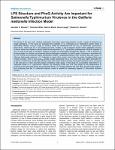LPS Structure and PhoQ Activity Are Important for Salmonella Typhimurium Virulence in the Gallleria mellonella Infection Model
Bender, Jennifer K.
Wille, Thorsten
Blank, Kathrin
Lange, Anna
Gerlach, Roman
The larvae of the wax moth, Galleria mellonella, have been used experimentally to host a range of bacterial and fungal pathogens. In this study we evaluated the suitability of G. mellonella as an alternative animal model of Salmonella infection. Using a range of inoculum doses we established that the LD50 of Salmonella Typhimurium strain NCTC 12023 was 3.6 × 103 bacteria per larva. Further, a set of isogenic mutant strains depleted of known virulence factors was tested to identify determinants essential for S. Typhimurium pathogenesis. Mutants depleted of one or both of the type III secretion systems encoded by Salmonella Pathogenicity Islands 1 and 2 showed no virulence defect. In contrast, we observed reduced pathogenic potential of a phoQ mutant indicating an important role for the PhoPQ two-component signal transduction system. Lipopolysaccharide (LPS) structure was also shown to influence Salmonella virulence in G. mellonella. A waaL (rfaL) mutant, which lacks the entire O-antigen (OAg), was virtually avirulent, while a wzzST/wzzfepE double mutant expressing only a very short OAg was highly attenuated for virulence. Furthermore, shortly after infection both LPS mutant strains showed decreased replication when compared to the wild type in a flow cytometry-based competitive index assay. In this study we successfully established a G. mellonella model of S. Typhimurium infection. By identifying PhoQ and LPS OAg length as key determinants of virulence in the wax moth larvae we proved that there is an overlap between this and other animal model systems, thus confirming that the G. mellonella infection model is suitable for assessing aspects of Salmonella virulence function.
No license information
Related Items
Show related Items with similar Title, Author, Creator or Subject.
-
2015-06-01ZeitschriftenartikelOutbreak of Uncommon O4 Non-Agglutinating Salmonella Typhimurium Linked to Minced Pork, Saxony-Anhalt, Germany, January to April 2013 Alt, Katja; Simon, Sandra; Helmeke, Carina; Kohlstock, Claudia; Prager, Rita; Tietze, Erhard; Rabsch, Wolfgang; Karagiannis, Ioannis; Werber, Dirk; Frank, Christina; Fruth, AngelikaIntroduction: In January 2013, the National Reference Centre for Salmonella (NRC) detected a salmonellosis cluster in Saxony-Anhalt, Germany, caused by uncommon O4 non-agglutinating, monophasic Salmonella (S.) Typhimurium ...
-
2014-01-02ZeitschriftenartikelInflammation Fuels Colicin Ib-Dependent Competition of Salmonella Serovar Typhimurium and E. coli in Enterobacterial Blooms Nedialkova, Lubov Petkova; Denzler, Rémy; Koeppel, Martin B.; Diehl, Manuel; Ring, Diana; Wille, Thorsten; Gerlach, Roman; Stecher, BärbelThe host's immune system plays a key role in modulating growth of pathogens and the intestinal microbiota in the gut. In particular, inflammatory bowel disorders and pathogen infections induce shifts of the resident commensal ...
-
2009-12-17ZeitschriftenartikelMorphology of Salmonella Typhimurium typing phages of the Lilleengen set Eisenstark, Abraham; Rabsch, Wolfgang; Ackermann, Hans-W.The Lilleengen scheme for typing Salmonella enterica serovar Typhimurium consists of 12 tailed phages. Ten phages are podoviruses and morphologically identical to Salmonella phage P22. Two phages are siphoviruses and ...

